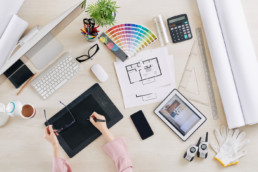Tools and Trends for Interior Designers
In this video, Marc Molinsky shared with designers from the Design Leadership Network about tools, assets, trends and upcoming innovation for Interior Designers.
Common Attributes of Highly Successful Design Firms
By Marc Molinksy, CEO of DesignerAdvantage
As CEO of DesignerAdvantage, I have had the pleasure of working closely with hundreds of interior design firms throughout the United States over the last 15 years. My job has provided me with a unique vantage point into all of the different ways that interior designs manage all of the intricacies of their firms.
I was recently reflecting back on my many years of experience in this industry and it occurred to me that the most successful design firms all shared 5 attributes regarding the manner in which they run and manage their businesses. These common 5 attributes are as follows:
Great Customer Service
Running a highly successful design firm starts with providing great customer service. In the same manner in which The Four Seasons and Ritz Carltons treat every encounter with their customers with the greatest of care and attention to detail, the most successful design firms use the same approach with their clients.
Providing great customer service entails promptly and thoroughly responding to all client requests and proactively keeping them informed on the progress of the project.
The best design firms understand that there is no detail too small when it comes to working with high end clients.
Accountability
It is inevitable that some things are going to go wrong on most design projects. The best firms understand that every problem is a golden opportunity for them to demonstrate their integrity and accountability to their clients.
In my experience, the most successful firms immediately take full ownership of all problems on a project and they do whatever is necessary to “make it right” with the client.
Positive Culture
Firms that have been able to create a culture of excellence and positivity seem to attract and retain the best employees and clients. Positive energy within a firm is generated when the principals create an environment where everyone in the firm is required to be highly respectful of one another at all times. It is also created by challenging each employee – in a positive manner - to perform their work at the highest possible level of quality and excellence.
Proficient at Billing Time
The best firms are fearless and unapologetic when it comes to billing their time on a project. Even though they might receive negative feedback from their clients from time to time, they continue to bill their time with confidence because they understand that time billing is essential to their firm’s financial well-being and their clients have agreed to it in writing.
Know When to Say “Goodbye”
Another common attribute about successful firms is that they are not shy or hesitant to terminate clients that do not value their work or are not willing to pay for their time. Although every firm has to deal with this type of client at some point, the most successful firms understand that these clients can quickly destroy the morale of themselves and their employees resulting in lower quality work and high turnover – and ultimately less profitability.
Time Billing for Interior Designers
As the leading provider of bookkeeping and expediting services to interior designers in the United States, we have seen first-hand how the interior design industry has been changed dramatically over the past 20 years. No change in the industry has impacted design businesses more than the way designers charge fees for their services.
Pre-1990, the interior design business model was originally designed to build in all or most of a designers’ fees directly into the price of the product. This technique, called “charging retail” allowed interior designers to receive a “built in” 40% profit margin (which also equates to a 67% “markup” on the designer net price). For example, if a designer were to sell a sofa to a client with a $10,000 suggested retail price, they would achieve a profit of $4,000 because their net designer price would typically be 40% “off retail” or $6,000. This “built in” profit margin of 40% was precisely what a design business needs to achieve a reasonable bottom line.
This “retail” model was quickly blown up by the internet when consumers for the first time had gained transparency into designers’ profit margins. Consumers were quick to condemn this model because they could not imagine how and why a design business would need to make some much money on product to sustain their businesses. Consequently, designers were forced over to reduce their markups on product from 67% down to 35-40% despite the fact that the cost to run their businesses had not changed and if anything went up. Given the financial reality that a design business cannot run their businesses on simply a 35% markup, designers slowly over time began charging hourly for their time.
The evolution of the time billing model for interior designers has overall been a positive change for the industry but it is a model that has some challenges that must be overcome for a designer to achieve a healthy profit margin. Based upon our years of experience and research, the following is a list of the top 5 challenges that designers are currently facing with time billing along with our recommendation for how to solve them:
Keep Description of Time on Invoice Short
It is very common for interior designers to use very lengthy descriptions of their work in their time billing invoices with the intention of “answering all of the clients questions up front”. Our experience has shown us that lengthy descriptions make the billing process far more tedious and cumbersome and though not intuitive, it actually results in more client grumbling, not less. We recommend that you group and present your time in general categories such as: sourcing, client communication, vendor communication, on site meetings, project management, project administration, travel and construction management. This approach will speed up the time billing editing process and reduce the amount of painful client feedback.
Negative Client Feedback
It is very common for interior designers to receive negative feedback from their clients about their time billing invoices because clients do not have a clear understanding of how much time and effort is required behind the scenes to bring a design to reality. This negative feedback can significantly impair a designer’s confidence and consequently cause them to invoice far less time than what their contractual arrangement allows. We recommend that you carefully consider what type of client is giving you negative feedback before making any changes to your time billing process. We recommend that you classify each of your clients as either A, B or C. A & B clients are reasonable people that value what you do for them and they are interested in you making a profit on your work. C clients do not value your time or your design, regardless of their net worth, and therefore you should not take their criticisms to heart because they are not reasonable in nature.
Find the Right Time Tracking System
There are countless systems currently being used by interior designers to track and invoice time (ie. Microsoft Excel, Google docs, Quickbooks, Studiodesigner, Harvest and DesignerLinkapp.com). Finding the right system for your firm can be challenging due prodigious number of options. We recommend that you try and use the same system for both of your time billing and accounting – so if you use Quickbooks for accounting, it is best to use Quickbooks for your time billing (the same holds true for Studiodesigner). Our experience shows that Harvest and Designerlinkapp.com are the most user friendly and popular time billing software other than Quickbooks and Studiodesigner.
Managing Client Expectations
Due to the tremendous amount of time that goes into a design project, it is imperative to manage the clients’ expectations of your time billing from the very beginning of a project. Although it must be explained to the client that it is impossible to give them an exact estimate of your time before the project starts, you can tell them that time billing usually represents 20-30% of the total project spend (which includes the sum of hourly billings, cost of product of labor and markup). You can also explain that where they fall in that range will depend on how custom and how decisive they are during the sourcing process.
Are Your Billing Rates in Line with the Market?
Interior designers generally do not have access to the time billing rates of other firms in their region so it is a very common problem for firms to be charging far less for their time (or more) than the market rates. We recommend that you try to join a network of designers in your area that are comfortable in exchanging information about their own firms in a “non-threatening” way. These designer groups are growing in popularity and likely to present in your city.
5 Reasons Outsourcing Makes Sense for Interior Designers
This article was originally published in the American Society of Interior Designers Magazine Publication in the CA San Diego Vol 2, 2020, on August 20, 2020.
To read the original article, click here.
5 Reasons Outsourcing Makes Sense
By Marc A. Molinsky
“Outsourcing” is becoming more popular with interior design firms than ever before. In fact, our research shows that nearly 8 out of 10 interior design firms outsource at least one component of their business to a third party. As labor and benefits costs continue to increase, it has become much riskier and more expensive to hire in-house employees. This increasing demand for outsourcing has resulted in many more businesses popping up within the interior design industry that offer outsourcing.
The most common task that designers outsource is bookkeeping. Bookkeeping is the ideal candidate for outsourcing because it is not a skill that is taught in design school and it is very expensive to hire and manage in-house. DesignerAdvantage, Inc. has become the leading provider of outsourced bookkeeping and ordering services for interior designers because they understand all of the intricacies of the design business.
Other tasks that are commonly outsourced by designers are CAD drawings, purchasing/ordering, social media management and public relations.
One of the newer outsourced services within the industry is the work typically performed by an assistant designer such as sourcing, budgeting, project management and installations. Coupar Consulting, a consulting firm based out of San Francisco, is the first in the industry to offer a unique suite of services for interior designers which includes assistant design work, public relations, website design and social media management.
There are the 5 primary reasons why outsourcing has become more popular in the interior design industry:
Reduce Cost
The most popular reason to outsource business functions to a third party is to reduce costs. Outsourced providers can execute tasks faster and cheaper than in house employees because they hyper focus their business and invest heavily on perfecting that one task resulting in savings and efficiencies for their clients.
Variable Expense
Variable expenses are business expenses that typically increase or decrease along with the size of sales and they can be controlled and “turned off” as needed. Examples of variable expenses are sales and marketing, office supplies and consulting. Fixed expenses are expenses that cannot be turned off such as payroll, rent, and insurance. Outsourced services are considered variable and therefore, are more attractive for your firm.
Focus on what you do best
By outsourcing your firm’s “non-core competencies” you are allowing you and your employees to focus the majority of your time on the aspects of your business that you do best, which results in happier employees, better employee retention and most importantly, a higher level of customer service for your clients.
More time to grow your firm
Your firm will function better and faster when your internal staff are not spending a significant amount of their time the smaller, less critical tasks of the business. Outsourcing allows you to increase the capacity of your firm to take on more business without the expense and time needed to hire and train new employees.
Best Practices
When you outsource you are essentially hiring an “expert” in that particular task and therefore you have access to the best practices in that particular area of the business. Our research shows that design firms who opt to outsource non-core competencies to a third party generally are happy with their decision and tend to commit to those resources long term.
To read the original article, click here.
Peer Benchmarking Can Save You Thousands - 6 Critical Statistics
Comparing Your Firm to Your Peers Can Save You Thousands
Benchmarking is a key to success
At DesignerAdvantage, we find the most successful interior design firms are the ones who spend time benchmarking their companies alongside their peers in the industry. Whether it is size, location, or another sector, integrating benchmarking into your process will give you valuable data that allows you to establish baselines, identify areas of improvement, and become more competitive in your space.
Benchmarketing helps your firm:
- Get an outsider’s perspective of your success
- Keep an eye on your performance and changes over time
- Identify areas for improvement within your firm
- Set proper goals and expectations moving forward
- Find the gaps in your profitability and optimization
- Standardize your metrics
6 Stats You Need to Know
#1: Gross Revenue Per Employee
Productivity is key in our industry. We know your designers are hard at work providing value to your customers; but how productive are they really? By knowing your Gross Revenue per Employee numbers, you are finally able to determine whether your employees are bringing in the value you need from them.
Say you have an incredible team member, who provides quality work, but after running your numbers, you realize they are managing only $100,000 in product in 2021 while the average for your team turns out to be $500,000! If this employee’s salary is around $50,000, your profitability on them is too low, and you’re not actually bringing in revenue from their efforts.
By knowing these numbers, you can finally start digging into the root cause of why this employee is unprofitable for your firm. Now, you can help train them to overcome weaknesses or move your employees around to focus on their strengths. And as you grow or refine your team, you can better understand who may not be bringing value and stop spinning your wheels when it comes to hiring and firing.
In our decades of experience managing finances for interior design firms, we firmly believe that without knowing your Gross Revenue per Employee, you can never reach your full potential as a company. You can triple your business, but without increasing gross revenue, it will only cause chaos!
#2: Time Billing
Many firms ask us, should I use time billing or flat fees to invoice my clients for employee hours? We believe there are pros and cons to each, and it’s critical that you understand your own numbers and compare your firm’s numbers to your competitors.
When it comes to time billing, one of the first tasks is to examine your market. Every area of the country is different, with varying billable rates and expectations. One of the keys to success with time billing is ensuring that your employees each about 80% of hours worked in their invoices. Without billing 80%, you will fall short in your profit margins and find time billing to be expensive and undervalued.
By comparing your numbers to your peers, you will be able to see what percentage of hours worked vs. hours billed your main competitors averaged, and determine if this is the right path for you.
Here are 3 things you need to maximize your profit with Time Billing:
- Make sure you’re charging market value for time/billing rate per employee
- Make sure your employee is charging as close to 80% of hours work as possible
- Make sure that you’re paying your employees a proper/reasonable salary relative to what the market is. If you’re paying them way over the market in salary that will hurt your profitability.
#3: Flat Fee Billing
Flat Fee billing can often feel easier than time billing. However, we always caution our clients that with Flat Fee Billing, you must know your numbers (and your peers’ numbers) regarding how much time is actually being billed versus how many hours are going unpaid. For example, with Time Billing, its important to try and bill 80% of hours worked.
To determine Flat Fee Billing rates, you need divide the flat fee by the number of hours that your whole team is working to see what percentage of your hours are being billed to the client. Generally, Flat Fee Billing results in about 30-40% of your team’s hours being invoiced to your clients. It’s shockingly lower than Time Billing!
The challenge with Flat Fees arises because it’s nearly impossible for your client to imagine just how many hours will actually go into getting your project completed. We all know how challenging the interior design industry is, and feel the pain of a new client balking at your estimation of time and effort, simply because they could never dream of the number of revisions, changes, management and consultation that is going into their project.
This is why a peer analysis of your market will do wonders for your decision on Flat Fee versus Time Billing, and will also help you ensure that you are billing enough of your employee hours to make it worth it. We want to make sure that you feel your clients are paying and appreciating the effort you put into their designs.
#4: Cashflow
We all know that having healthy and positive cash flow is essential to any small business. It’s truly impossible to have a sustainaby profitable business while experiencing cash flow issues, and unfortunately, just because you are “profitable” in your excel sheet, doesn’t mean you have good cash flow.
Here are a few examples of how a firm could be profitable but still be in cash flow pain:
- You’re not collecting Time Billing or Flat Fee Billing in a timely manner. Sure, you may be quickly sending off invoices, but if your client isn’t paying you in a reasonable amount of time, the pain your books feel can be immense.
- You’re fronting any money to vendors before your clients pay you for those orders. This can cause you a lot of stress and pain and is a fairly common issue. No one wants to lose a client because of delays in orders, so often designers get anxious and want to get the order out the door before the client pays. This is not sustainable!
- The owner is taking money out of the business and reducing profits. If you do not have your owner disbursements balanced with your profits, your business will quickly suffer. It’s critical to compare your owner’s draw to your peers’, and also compare your disbursements to your cash flow to ensure you’re keeping your company afloat.
Keeping a clear bird’s eye view of your cash flow will help reduce pain, and comparing your numbers to your peers will help you sleep at night, knowing you are keeping a balance in your firm for long-term growth.
#5: Overhead as a Percentage of Revenue
Overhead is the amount of non-project-related expenses. It’s basically the cost of running the business in every way minus the actual design projects. From the cost of managing the back office, to your rent, utilities, insurance, accounting, marketing and lawyer fees, these numbers matter and you want to ensure you stay within your market’s averages.
Why is this so important to know? Because often, a design firm may appear at first glance to be very profitable. You may be doing great with your Time Billing rates, keeping clients paying quickly, and drawing a nice number as the owner. However, if you run a true peer analysis report, and crunch your own numbers to determine your Overhead as a Percentage of Revenue and find it to be higher than market averages, you will end up wasting most of your profits in ways could have been avoided.
Interior Designers are working extremely hard as it is, and you can’t afford to spin your wheels on projects only to miss out on the fruits of your labor simply because you’re paying triple the rent that your competitors pay, or you have one too many high-salary employees.
At DesignerAdvantage, we’ve found this mismatch between overhead and profits to be one of the greatest motivators to get a peer analysis report. It’s nearly impossible to find these averages “in the wild,” and yet its critical to the financial health of your firm.
Also note that comparing your gross margin to your peers can greatly improve the profitability of your firm as well. Healthy firms average a 35-45% gross margin the interior design industry. If your gross profit is under 35%, it means that 1) your markups are too low or 2) you’re not billing enough time, or 3) your billing is too low.
#6: Net Income as a Percentage of Sales
And most importantly, we can never forget how critical understanding your Net Income as a Percentage of Sales is! This number is basically how many pennies on the dollar are left after you take all your profit from your jobs and your overhead.
To find this number, you will take the net income, divide it by your sales and determine the ratio. In order to have a healthy firm, you need to stay within a certain range (something you can determine more accurately with a peer analysis). Typically, this ranges in the 15-30% (from low end to high end of healthy).
Here are some common reasons why it might be less than that, or your net income percentage might be unhealthy:
- Your overhead is too high
- Your job profit is too low
- Your overall sales are too low
We can’t stress this enough: you must compare your net income as a percentage of sales to your peers to see if it's within a reasonable range. If it’s not, you need to compare and contrast to competitors and then fix the issues.
Healthy net income percentages actually vary a lot based on geography! Certain cities and states in the US where market value is might higher, clients are willing to pay significantly more per hour for your team’s time. For example, in San Francisco, we’ve found customers are willing to pay the highest time billing rate per hour in the country, with a maximum markup of around 30-35%. In Miami, however, with many international clients hiring designers for second homes, the willingness to pay market rates is much lower. This means in order to compete with local peers, your time billing and fees must reflect the customer benchmarks.
Contact us!
To get your customized 2021 Peer Analysis Report from DesignerAdvantage, contact our team today.
The New Normal for Interior Designers
The New Normal for Interior Designers
At the start of 2020, the economy was in an incredibly strong position. The unemployment rate hovered between 3-4%, the stock market was at an all time high, and consumer spending maintained strong volume. Then, as we all know... things changed. An unprecedented event occurred on a scale that none of us expected, and our economy quickly lost strength. By April 2020, unemployment had reached 10%, the stock market hit its lowest point in 4 years, and consumer spending dropped off a cliff. Interior design businesses were affected by this event, but not in the way many might think. Through our analysis, we have found some insight that should give interior designers confidence as we all move forward into an uncertain future. We go in depth about what has happened to the interior design industry so far in 2020, where the industry stands today, and what it means for your business.
In January 2020, the interior design industry was incredibly strong. Interior designers brought in almost 25% more revenue in January than they had on average monthly throughout 2019. Things were looking good, and businesses were preparing for a solid year of growth. Then, from January to May, sales began to fall. Clients of designers held tightly to their cash as the pandemic began to unfold, and the entire economy began to falter as we all hunkered down until we could figure out a path forward. As one would expect, interior designers were not immune to this slowdown in businesses. Designers saw a steady decrease in their revenue month over month, and in May, the average design firm made just 57% of the amount of revenue it had previously earned in January 2020.
Thankfully, in June 2020, things started to look better. Prospective clients began to realize how much time they were spending at home, and those who were fortunate enough to continue working had more disposable income as a result of decreased spending in prior months. With this, people began to look for ways to upgrade their newly combined living and working environment, and designers began to attract new business. Over the next few months, designers began to chip away at their previous losses, and by September 2020, the design industry was back to the same sales volume it had seen in January 2020. Miraculously, over the course of just 4 months, the design industry had rebounded to its previous high in monthly revenue.
This year has been a lot, and the looming growth of a second wave of coronavirus cases is not making it any easier. There are still a lot of things we do not know.... When will we get a vaccine? Will we need to lockdown again? Will things ever go back to normal? However, despite the uncertainty, there are some takeaways we have for designers:
Your business can bounce back quickly.
Per our analysis, interior designers are already back to the sales volume they saw pre-pandemic. This industry has been affected by the pandemic, but it recovered quicker than most sectors because consumers are staying home more, and looking to upgrade their space. In the long run, opportunities for interior design business will continue to grow in the residential space, even if a second wave puts us in lockdown.
The change is good for your business.
With many people now working from home for the 8th month in a row, many businesses are starting to broach the idea of continuing with the remote working environment even after the pandemic is over. This is good news for interior designers on two counts… 1) When your clients are out of the office, residential business expands, and 2) Your business can now be more flexible as well. Perhaps you no longer need to rent an office? Perhaps you can outsource your bookkeeping or other back office tasks at a cheaper rate? Perhaps you can meet with clients or your team quickly via Zoom, rather than in person? The changing definition of work allows your business to be more lean by decreasing wasted time and business expenses, without sacrificing productivity and sales.
Don’t be afraid to ask for help.
For some, this analysis makes a lot of sense, and they have realized the recovery of the interior design industry in their business as well. But for others, this may feel like the opposite of what has happened. Maybe your business hasn’t realized the growth seen over the last few months? Maybe you had to decrease size to survive? No matter which way you put it, this has been a hard time. But... you are not alone, and your business can bounce back. Explore the idea of an outside consultant to help you forge a path forward. Our firm has helped designers navigate this pandemic, and we can help you too, but there are plenty of other resources we can refer to help you as well. Whatever you do, don’t let this rough year take your business. If you need help, just ask.
Podcast: Ron Werner and Marc Molinsky: Furniture vs Finance
In this episode of The Lounge, from The Chaise Lounge Podcast, Nick May chats with Ron Werner of HW Home, and Marc Molinsky of DesignerAdvantage for a fascinating conversation about his years of working with designers, as well as current industry trends and billing best practices.
Listen to the Podcast Episode Here: https://thechaiseloungepodcast.com/blog/2018/05/04/213-ron-werner-and-mark-molinsky/
Ron Werner and Marc Molinsky
Today in The Lounge, Nick chats with Ron Werner of HW Home. A native of Chicago, Ron began his professional career as a stockbroker prior to opening a series of home furnishing store. Next, Nick sits down with Marc Molinsky of Designer Advantage for a fascinating conversation about his years of working with designers, as well as current industry trends and billing best practices.
Early Beginnings
Ron began his career as a stockbroker in Chicago, Illinois, after graduating with a Bachelors in Economics from Indiana University. He says his years as a broker taught him the ins and outs of running a small business, and later, on a trip to Boulder, Colorado to visit his sister, Ron decided to move to the area and open his own shop along with his partner, Jim, who was currently running a Holly Hunt showroom in Chicago. The duo decided that purchasing real estate in the area would be the best investment and opened their first store in 1999.
The Store – HW Home
Ron and Jim always had a clear idea of what they wanted: a true home store that reflected their personal aesthetic. Now expanding into their third location, the look and feel of the store is still in alignment with their original business plan: they create an eclectic palette using their sourcing methodology of “ Hunt, Gather, Edit” — working to select items that are unique and beautiful, stand the test of time and will excite people.
Marc Molinsky – Designer Advantage
Next in The Lounge, Nick chats with Marc Molinsky of Designer Advantage. For 18 years now Designer Advantage has handled the financials and bookkeeping for interior designers, allowing for more time to focus on client relations and the creation of design vision. Designer Advantage handles the financial side of the business, ensuring that designers are paying bills and making a profit. Functioning as both a full-service booking company and an outsourced CFO, Designer Advantage provides services to designers at a cost less expensive than hiring a full-time employee. They currently manage 120 firms across the country.
Industry data
Designer Advantage has been in business for 18 yrs, and during this time they have seen a shift in the way in designers are being compensated for work. Originally, profit was generally tied to product, with designers making 35-45% profit markup on top of the flat fee. This practice has deteriorated over time as designers lose the competitive advantage of purchasing trade only products. More notably, when markup profit is divided by the hourly rate, the numbers simply do not add up — resulting in designer not being properly compensated for the amount of hours spent. Therefore, the industry has been shifting toward an hourly model which can help designers increase their profitability.
Time Billing Best Practices
As Designer Advantage sits on the front lines preparing and receiving invoices for the client they possess a unique vantage point. As such they have developed a few techniques to minimize negative client feedback, to help your interior design business weather the seismic shifts we’re all seeing in the industry. Listen to take a deep dive!
Featured: How to Deal with the Boss and How to Deal with Being the Boss
How to Deal with the Boss and How to Deal with Being the Boss
BY CINDY HICKS · 11/15/2017
Having been on both sides during my decades of experience in the interior design industry, I can tell you that a bad boss—or just a poorly managed company—can be completely demoralizing to an employee, whether it’s all at once or whether it occurs over months or even years of accumulative hassles. Several of the designers who contribute to this site have gone from apprentice to employee to owner (and one even went back to being an employee). It’s a common story and transition in the interior design world, in other words. And so, I wanted to share some insights and resources for how to deal with a bad boss and for dealing with being the boss.
Reliable Payroll and Accounting
Like employers in most industries, it can quickly sap the morale of your team if the payroll isn’t on time or isn’t accurate. Accounting services can be some combination of expensive or unreliable. Hire an accountant you can’t trust and it could end up costing your business tens of thousands of dollars, if not more. If an online payment account, like Ivy, isn’t enough to manage your financial accounts, Designer Advantage is a great option for general bookkeeping. Once you hire an employee or two, you’ll also be looking for cheap payroll software options like Advanced Micro Solutions.









